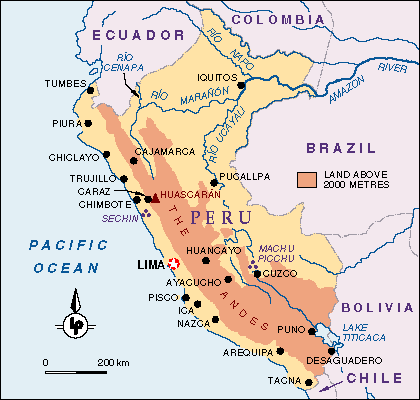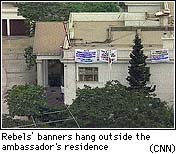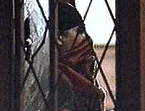


 I. CASE
BACKGROUND
I. CASE
BACKGROUND Emperor Akihito at the Japanese
ambassador's house in Peru. This celebration is a prestigious event
every year for Japanese embassies around the world. The guest list
included Lima's most important political and social figures,
including the foreign and agricultural ministers, the president of
the Supreme Court, six Supreme Court justices, five generals of the
National Police and Fujimori's mother, sister and brother. Also
present was U.S. Ambassador Dennis Jett, who left the party early,
and seven U.S. diplomats, that lingered a little longer. The only
person missing and perhaps the most important one was President
Fujimori.
Emperor Akihito at the Japanese
ambassador's house in Peru. This celebration is a prestigious event
every year for Japanese embassies around the world. The guest list
included Lima's most important political and social figures,
including the foreign and agricultural ministers, the president of
the Supreme Court, six Supreme Court justices, five generals of the
National Police and Fujimori's mother, sister and brother. Also
present was U.S. Ambassador Dennis Jett, who left the party early,
and seven U.S. diplomats, that lingered a little longer. The only
person missing and perhaps the most important one was President
Fujimori. The guests were enjoying the pleasant summer evening sipping champagne and cocktails and eating sushi. But all the festivities came to a dramatic halt at about 8:00 pm. Without warning, an explosion shook the entire house. In less than a minute, 14 masked men and women, some of them teenagers, clambered through the hole they had opened in the garden wall, and slipped behind the trees. Two of the intruders took positions at the front entrance. And then, finally, an announcement was made that left everyone astonished and in fear. "This is the Tupac Amaru Revolutionary Movement. Obey and nothing will happen to you. [Schemo, 1997]"
The rebels began shooting in the air, and ordered the guests to hit
the ground. They warned the people not to look at them, though they
concealed their faces behind the movement's trademark red, white
and black bandanas. The police quickly responded to the attack, and
for the next forty
As soon as the firing stopped, the rebels announced that they would release all the waiters, women and elderly guests. However, when they opened the door to let them out, the police lobbed tear gas into the house. The rebels had come prepared with gas masks, and were hardly effected by the gas. The guests grabbed handkerchiefs or paper napkins for protection. Aoki took the megaphone and repeated his request for the police to hold their fire. He then turned to El Arabe. "Let these people go,'' he told him. "They've got nothing to do with this. I, alone, am important enough for you to bargain with. [Schemo, 1997]'' Only then did the police hold up and guests begin to file out.
As the elderly and women began to evacuate, Sally Bowen, a
journalist, told a guerrilla standing near her that she wanted to
stay. Her request was denied, but before she was released she was
taken to meet the commander of the operation,
Movimiento Revolucionario Tupac Amaru
The Movimiento Revolucionario Tupac Amaru (The Tupac Amaru
Revolutionary Movement, MRTA) was founded in Lima and took up arms
in 1984. Today there are an estimated 300 to600 members, and they
operate mainly in the upper and central Huallaga Valley. This area
is in eastern Peru, and has been controlled by both MRTA and
Sendero Lumninoso (Shining Path) rebels for the past 20 years as
well as narcos (drug traffickers) and anti-drug authorities.
The MRTA named themselves after an 18th-century leader who fought
Spanish colonial rule, that leader had taken the name Tupac Amaru
from the last ruler of the Incan empire. To an extent, their name
alone reveals plenty about their background and philosophy. The
MRTA has attempted to "liberate" the mostly indigenous populations
from oppressive government rule, and follow in the steps of the
Cuban Revolution, mainly inspired by the words of Che Guevarra.
The majority of MRTA members are from rural areas and peasant
farming villages in the jungle, most from indigenous predecessors.
However, in recent years the MRTA has attracted college students
who have become frustrated with the socio-economic conditions of
the country and have studied leftist teachings. The group had been
led by Victor Polay, who happened to be a college roommate of
former President Alan Garcia in the early 1970s. Polay was captured
in 1992 and is serving a life prison term, as is his lieutenant,
Peter Cardenas. Until the siege on the ambassador's house in
December, the MRTA had no major attacks. Instead they had several
car bombs, minor kidnappings, and threats on businesses.
Public Opinion and the Government's Response
Although public opinion surveys show that most Peruvians do not
sympathize with rebel movements and are vehemently opposed to
terrorist violence, experts who have studied the country's
insurgencies say that Peru will not overcome rebel activity and
related violence until it alleviates the social and economic
problems that draw people into these groups [Sims, 1997]. (For more
see "Arrest of rebel's kin" at Latinolink.) "The guerrillas'
message is still appealing in Peru not only because there is
rampant poverty but also because there are so many people,
especially young people, whose
Responses from villagers to the recent events have shown some
sympathy for the rebels, particulary the younger members. For
example, one shopkeeper from the MRTA home base had this to say
about the whole ordeal. "I don't see why they had to kill them all.
Any person, knowing that they're about to die, would repent, and as
long as they're alive, they can change.'' The shopkeeper agreed
that Fujimori had the right to order the raid on the compound,
saying, "There were innocent people
in there, and they had families that were suffering each day they
were held.'' (More on
hostages.)The same person also stated that something had to be
done about the continued use of violence by rebel groups [Schemo,
1997]. "I'm poor, but I have thoughts and feelings, too,'' the
shopkeeper repeated several times.
Others make a clear distinction between the MRTA and The Shining
Path. When one woman was asked about her feelings toward the MRTA
and its leader, Cerpa, she said that they were not in the same
class as the Shining Path. "He was not a terrorist,'' she said. "He
was a revolutionary.'' Another woman added, speaking low so as not
to be overheard, "He fought for us, for the poor. Look at how we
live. Look at how we die [Schemo, 1997]." People were most shocked
by reports that stated the band of youths in the siege seemed
naive, and that one had asked a hostage whether it was possible to
walk back to Peru from Cuba, where they had been offered asylum.
Successive Peruvian regimes have carried out vicious counter-
insurgency tactics to put an end to rebel and terrorist violence.
Tens of thousands have been massacred, disappeared or executed by
government forces. In 1983 and 1984 alone, the Peruvian military
slaughtered 8,700 mainly poor peasants in their effort to crush the
revolution. Between 1983 and 1992, over four thousand people were
"disappeared" and thousands of others killed, including 500 which
were slaughtered in 19 separate massacres, by military and police
forces [Schemo, 1997]. In 1992, Fujimori, staged a coup to assume
dictatorial rule over the country and institute even more sweeping
reforms against the rebel movements. A few weeks after his coup,
Fujimori carried out a massacre of 40 revolutionary prisoners at
Canto Grande prison, today a battle cry for the MRTA [Schemo,
1997]. The number attacks has declined since Fujimori's government
captured top rebel leaders in 1992. But a series of well-planned
assaults, like the one in December, have raised questions and fears
that the groups are resurfacing.
The Hostages Freed
The MRTA captors warned that they would start killing captives if
Fujimori did not appear for face-to-face talks. The MRTA demand and
goal was the release of more than 450 MRTA members being held in Peruvian
prisons. But the deadline for the executions came and went and
Cerpa backed down. Instead, he announced that there would be no
killing, at least not by the Tupac Amaru. Hostages say, Cerpa tried
to win them over, engaging them in philosophical conversations
about the free market economy and the poor whose lot, he strongly
felt, would never improve. He inquired about The MRTA's public
standing, and whether Peruvians distinguished between the Tupac
Amaru and the more violent Shining Path. At one point Cerpa
suggested that the Tupac Amaru could transform itself into a
political party.
During the two weeks after the invasion, the rebels released most
of the prisoners, including 225 in a "good-will gesture" shortly
before Christmas. At the end of four months there were 71 hostages
left in the compound. Fujimori and the rebels took part in
negotiation talks but those talks only seemed to go in circles.
Meanwhile, Fujimori almost immediately began taking steps for a
counterattack to rout out the guerrillas. Before Christmas, a team
of 140 commandos began training, working out maneuvers on a mockup
of the Japanese ambassador's residence.
Ultimately, it was those very same forces that released the
hostages in less than an hour without critically hurting any of the
hostages. All the rebels were killed and later buried in unmarked
graves. The government only disclosed the identity of two of the
rebels and refused to permit any funeral services. The closing
moments of this episode in Peru's long-standing civil war has
brought relief to many and worry to others who fear retaliation is
inevitable.
Continent: South America
Region: West South America
Country: Peru
Historically, Lima has always been the seat of government, trade,
and industry and has controlled the highland regions where most of
the indigenous populations and the argiculture takes place. But as
can be seen by the figures below the majority of the population is
ruled by the minority.
Most of the non-indigenous population continue to view the indian
populations culturally and racially inferior, and this has led to
the continual siezing of community lands. Much of these community
lands have been cultivated by the indigenous peoples of Peru for
centuries, and a majority of these lands are also of great cultural
and religious value to the peoples who inhabit them. Although
former presidents, such as General Alvarado, have tried to
institute land reforms and grant peasants better land rights, more
just agrarian reforms and land rights have been detained by
military coups and intervention from land owners and large
agricultural companies.
The principle obstacles indigenous communities face when attempting
to struggle for better representation are:
Poole, Deborah and Gerardo Renique. Peru: Time of Fear, Latin
American Bureau, 1992.
Schemo, Diana Jean. New York Times News Service 28 April 1997.
Simpson, John. In the Forests of the Night, New York: Random House,
1993.
Sims, Calvin. New York Times News Service 23 April 1997.
Sims, Calvin. New York Times News Service 5 April 1997.
Tulchin, Joseph and Gary Bland. Peru in Crisis: Dictatorship or
Democracy?, London: Lynne Rienner Publishers, 1994.

 Although the groups is
most known for its violent attacks, such as the raid on the
ambassador's house, it is known to local populations as a "Robin
Hood" type organization, stealing from the rich to give to the
poor. On several occasions the group has demanded food and clothing
in exchange for hostages, later distributing the food and clothing
in Peru's shantytowns.
Although the groups is
most known for its violent attacks, such as the raid on the
ambassador's house, it is known to local populations as a "Robin
Hood" type organization, stealing from the rich to give to the
poor. On several occasions the group has demanded food and clothing
in exchange for hostages, later distributing the food and clothing
in Peru's shantytowns.  dreams are deferred,'' says
Cynthia McClintock, a professor of political science who
specializes in Latin America at George Washington University [Sims,
1997]. Close to half of Peru's 24 million people live in poverty,
85 percent of workers do not have full-time jobs, and nearly 17
percent live in extreme poverty, meaning they are not adequately
nourished [Sims, 1997]. Although most of these conditions pre-date
President Alberto Fujimori, the percentage of Peruvians living in
poverty increased last year to 49 percent, from 46.5 percent in
1994, according to Caunto S.A., an economic forecasting firm [Sims,
1997].
dreams are deferred,'' says
Cynthia McClintock, a professor of political science who
specializes in Latin America at George Washington University [Sims,
1997]. Close to half of Peru's 24 million people live in poverty,
85 percent of workers do not have full-time jobs, and nearly 17
percent live in extreme poverty, meaning they are not adequately
nourished [Sims, 1997]. Although most of these conditions pre-date
President Alberto Fujimori, the percentage of Peruvians living in
poverty increased last year to 49 percent, from 46.5 percent in
1994, according to Caunto S.A., an economic forecasting firm [Sims,
1997].
3. Duration: 1996
4. Location
5. Actors: Peru and Tupac Amaru
 II. Environment
Aspects
II. Environment
Aspects 6. Type of Environmental Problem: Habitat Sea
7. Type of Habitat: Tropical
8. Act and Harm Sites:
Act Site Harm Site Example
Peru Peru Peru Civl War and Habitat
 III. Conflict
Aspects
III. Conflict
Aspects9. Type of Conflict: Civil
Contrary to popular belief, the MRTA and the Shining Path are not
one in the same, but rather they are arch rivals. The Shining Path,
with about 2,000 active members, considers MRTA members traitors to
communism, and the two groups have been warring against each other
for over a decade in the Huallaga Valley. Abimael Guzman, Shining
Path's founder, was captured in Lima >
Transfer interrupted!
involved financing from narco-traffickers on the
side of the Shining Path. The growing of coca and the presence of
drug-traffickers have always been a source of contention and
rivalry between the rebel groups. It is estimated that more than
35,000 people, mostly civilians, have been killed as a result of
the conflicts between the government and the rebel groups.
10. Level of Conflict: Middle
11. Fatality Level of Dispute: 10,000
 III. Environment and Conflict Overlap
III. Environment and Conflict Overlap12. Environment-Conflict Link and Dynamics: Indirect
Although the civil conflict centers around leftist rebels and the
government, its roots go much deeper. Like most of Latin America,
the primary arguments have been over land, including land rights,
monocropping, and the growing of coca, and the racial tensions that
have persisted since the 18th century.
Indigenous 45 - 47%
Mestizos 32 - 37%
Europeans 12 - 15%
Blacks and mulattos 2%
Asian
(Japanese and Chinese)about 1%
13. Level of Strategic Interest: State
14. Outcome of Dispute: Victory
 IV. Related
Information and Sources
IV. Related
Information and Sources15. Related ICE Cases
16. Relevant Websites and Literature
Relevant Literature
